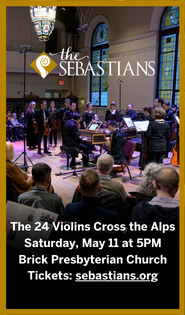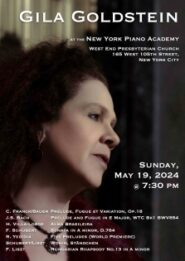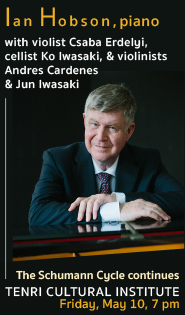Cage in a crypt opens the door to new worlds

John Cage is one of the most famous cultural figures of the 20th century and possibly the most misunderstood. His extraordinary intellectual and aesthetic legacy is often seen as permission to indulge in an anything-goes randomness, when it’s exactly the opposite—a rigorous system to separate sounds from the long-standing clichés of musical performance. Cage created music meant to remove expression from the performer and let the listener do all the interpretive thinking, or none at all.
But this didn’t come like Athena from Zeus’s head. Early in his career, Cage was a modernist composer, experimenting with new structural and instrumental techniques and trying to convey concrete emotions and ideas to the listener (he loved Grieg). That’s the period from which his most famous work, Sonatas and Interludes for Prepared Piano, comes.
On Cage’s birthday Tuesday night, pianist Adam Tendler honored the essence of both the expression and innovation of the work with a marvelous performance in the crypt under the Church of the Intercession.
This was the opening performance of the season for Death of Classical’s Crypt Sessions, and the timing was superb—not only for Cage’s birthday but for the chance to hear music that still has the permanence to transcend the flow of time and eras in the sonically luscious crypt, a calm and cool space in the middle of a heatwave in a busy city.
Tendler has expertise in the music that is hard-earned and personal. Before he had his own piano in his home, he had a portable silent keyboard, and used to it practice and memorize, line by line, the Sonatas. He described this in a brief program note, and also wrote how the piece was the first of Cage’s music he ever heard, and that he felt the score was a “sacred text.” This dedication showed in the performance, his playing had a deep physical quality to it that showed a close connection between the pianist and instrument, superb keyboard technique that served as a channel for the expression of possible meanings.
That expression made this a special evening. One frequently hears this music played with an objective sense that outlines the revolutionary qualities of the piano’s preparation, and takes a retrospective view of Cage as once, always, and forever an experimentalist. But like his contemporary peer, Italian pianist Agnese Tonlutti, Tendler played this with the more honest and perspective of the Sonatas coming from the point that Cage had reached in the middle and late 1940s. This is modernist—not experimental—music, with chords, melodic phrases, specific meters and rhythms that strive to convey emotional sensations.
That meant playing the music in the tradition of Schumann, or Grieg, as an expressive work that calls for the possibilities of touch, legato, dynamics. Tendler applied all these—his dynamics alone were the most musical one has heard in this work—and judicious bits of rubato and brief pauses, all the tools musicians use to show the listener how they hear the composer’s ideas. That brought out the emotional resonances that are there, just under the surface of the notes.
The opening chords of Sonata I were robust, grand, and Tendler pressed the juxtaposition of the earthy rhythms in Sonata V against the mysterious, seeming incomplete, phrases in Sonata VI. His playing also set apart the dynamic rhythmic structures in the Sonatas against the freer, more contemplative means and moods of the Interludes.
There was a constant feeling that Tendler was searching inside the music, not necessarily identifying any of the specific emotional states out of Indian philosophy that Cage was describing but insisting, through his playing, that the listener hear that there was human experience in the sounds. Sonata XII had great depth and intensity, and after the final Interlude Tendler played the last four Sonatas with the kind of shaping that set the final bar as a satisfying conclusion to an extended journey.
Playing the piece as piano music meant that the preparation came to even greater life. Even the most detailed digital recording cannot capture all the sonic complexities of the piano’s sound, and in the excellent acoustic of the crypt the process of these altered sounds decaying in the resonant space was remarkable. Things like the hollowed out chords in Sonata XV sounded like tubular bells being squeezed through a keyhole, while other sounds, pressed together, took on a life and musical structure of their own as they evaporated.
The Calidore Quartet plays Beethoven’s Grosse Fugue in the catacombs at Green-Wood Cemetery, September 20-22. deathofclassical.com






